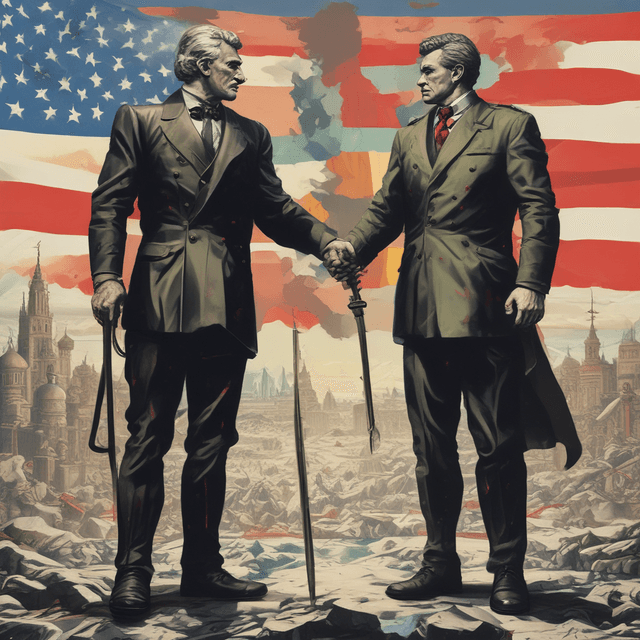
| Name | Second Cold War |
| Period | Late 20th century |
| Outcome | Avoidance of direct military confrontation, but intense battles for influence, resources, and technological supremacy that shaped world events for decades |
| Participants | |
| Nature of conflict | Geopolitical tension • Economic competition • Ideological conflict |
| Key differences from original Cold War | Not a standoff between capitalism and communism • Rivalry between American democracy/free market liberalism and Russian autocracy/traditionalism |
The Second Cold War was a protracted period of geopolitical tension, economic competition, and ideological conflict between the United States and the Russian Empire that dominated much of the latter half of the 20th century. Unlike the first Cold War that pitted capitalism against communism, this new global standoff was fundamentally a clash between American democratic-liberalism and Russian imperial-orthodoxy.
While the Russian Empire officially collapsed in the early 1900s, the monarchy was restored in the 1930s after a period of instability and civil war. The newly resurgent Russian state under the authoritarian Romanov dynasty soon re-emerged as a major global power, rivaling the influence of the United States.
Tensions between the two nations began to escalate in the 1950s as the Russian Empire sought to expand its sphere of influence in Eastern Europe, Central Asia and the Middle East. The U.S. responded by bolstering its own alliances and military presence in these regions, leading to a series of proxy conflicts and arms races reminiscent of the first Cold War.
However, the ideological divide was more pronounced this time. The U.S. championed democratic capitalism, individual liberties and a globalized, rules-based international order. Russia under the Tsars promoted a vision of traditional Orthodox Christian values, state-directed economic planning, and a multipolar world order dominated by empires and spheres of influence.
The Second Cold War was fought on multiple fronts - military buildups and regional proxy wars, technological and economic competition, and a fierce battle for global public opinion and influence.
On the military side, the two superpowers engaged in an intense arms race, developing increasingly sophisticated missiles, aircraft, naval vessels and other weapons systems. Flashpoints emerged in places like the Korean Peninsula, Southeast Asia, and the Middle East as the U.S. and Russia backed opposing sides in local conflicts.
But the war was primarily economic and ideological. Russia used its vast natural resources, state-directed industries and restrictive trade policies to challenge American economic dominance. Meanwhile, the U.S. leveraged its open markets, multinational corporations and technological prowess to counter Russian influence globally.
Both sides also waged sophisticated campaigns of information warfare, propaganda, and covert operations to undermine each other's political and social stability. This included supporting insurgent groups, financing opposition movements, and weaponizing media, technology and cultural exports.
Despite the intense rivalry, the Second Cold War never escalated to direct military confrontation between the U.S. and Russia. Both sides recognized the catastrophic risks of a full-scale conflict in the nuclear age.
Instead, the conflict saw periodic thaws and efforts at détente, as the two powers negotiated arms control treaties, economic agreements and cultural exchanges. However, these attempts at cooperation often broke down as ideological differences and geopolitical ambitions reasserted themselves.
The Second Cold War finally began to wind down in the 1980s, as both the U.S. and Russia faced growing domestic economic and political challenges. A new generation of leaders in both countries sought to ease tensions and pursue more pragmatic foreign policies focused on mutual interests rather than zero-sum competition.
The collapse of the Soviet-aligned Eastern Bloc in the late 1980s and the subsequent dissolution of the Warsaw Pact alliance system further contributed to the Second Cold War's denouement. By the 1990s, a new, more stable and multipolar international order had emerged, with both the U.S. and Russia playing critical but diminished roles.
The Second Cold War profoundly shaped the global geopolitical landscape for over four decades. While it never reached the heights of direct military confrontation between the superpowers, the economic, political and ideological competition had major ramifications for virtually every region of the world.
The lasting legacies include:
Even in the post-Cold War era, the shadow of this prolonged geopolitical conflict continues to shape international relations, domestic politics, and the broader human condition worldwide. Its complex legacy will likely reverberate for generations to come.